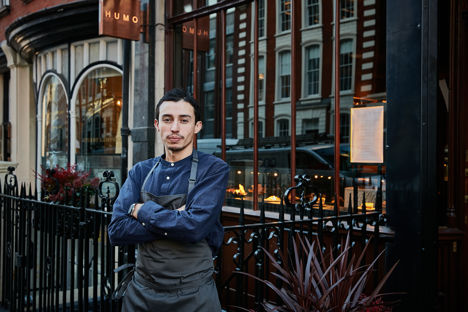
Ones to watch: Miller Prada
Having finessed his skills and understanding of Japanese cooking alongside mentor Endo Kazutoshi, chef Miller Prada is now spreading his wings at the helm of his debut restaurant HUMO, where electricity and gas are eschewed in favour of fire, smoke and wood.
Ones to watch: Miller Prada
Having finessed his skills and understanding of Japanese cooking alongside mentor Endo Kazutoshi, chef Miller Prada is now spreading his wings at the helm of his debut restaurant HUMO, where electricity and gas are eschewed in favour of fire, smoke and wood.
View more from this series:
Ones to watchThough their childhoods may look different, many chefs share an upbringing which was rooted in good food. It might be memories of a parent’s cooking, or foraging trips to gather local greens, but it’s no surprise that an early connection with what we eat, and where it comes from, often blossoms into a life-long love of food. Miller Prada is no exception. He was raised in Colombia's Bogota, surrounded by brilliant cooks, he says, with his great-aunt and grandmother in particular teaching him his culinary basics. There are memories of convivial feasts with neighbours at a nearby family farm, home-made cheese and farm-grown vegetables, as well as seemingly unremarkable moments which may have actually proved the most formative. ‘I remember being on the farm and eating scrambled eggs, and asking my great-aunt if I could have more,’ Miller says. ‘She asked if I knew how to make them – I didn’t, so she taught me. Making scrambled eggs on the farm is my first food memory.’
A seed was sown, though it hadn’t yet sprouted into thoughts of a career in cooking. Still, at sixteen, Miller took an after-school job at a local restaurant with a changing menu, themed around the styles of visiting artists. It served as his first introduction to the professional kitchen, and when he jetted off to Sydney soon after, following his wanderlust, he worked in a two-hat restaurant where he fully caught the culinary bug. ‘I started feeling all the rush and pressure of the kitchen and I loved it,’ he says. ‘I was fascinated. I’m a perfectionist and I saw all the chefs were driven by the same goal. It was under control and I thought 'this is where I belong'.’
From then, Miller hopped around the world, living and cooking in Hong Kong, Miami, Dubai and Lima, the latter of which proved particularly influential. There, as well as doing his Le Cordon Bleu training, he was first introduced to Japanese culture, thanks to the country’s Nikkei, or Japanese Peruvian, community, with which he found an affinity. ‘They were respecting every single ingredient,’ he says. ‘They respected the food for what it is. I thought ‘this is incredible, I have never seen it before’. I was used to seeing chefs try to transform an onion into 300 different things, apart from an onion. I appreciate that technique but I was more of the view that this is a simple ingredient which doesn't need too much doing to it.’
He arrived in London looking for fine dining experience, working alongside the likes of Jason Atherton, Brett Graham and, later, Endo Kazutoshi, at both Sumi and Endo at the Rotunda, where he played a large part in the opening team. The pair bonded, and Endo fast became a mentor to Miller, who is often described as Endo's protégé. I ask him about the teachings which had the biggest impact. ‘When I was twenty-three or twenty-four, I had a sous chef position, a good level but I would be very tough and rush in my reactions,' he says. 'Endo taught me something totally different; how to properly run a kitchen, how to run a team and how to create a team where everyone is comfortable. Yes, still working under pressure, but comfortably.’
Two years ago, Miller embarked on a new project, to launch his own concept with the Creative Restaurant Group (it's also behind Sumi and Endo at The Rotunda). HUMO, which translates as smoke in Spanish, was born, on the former Mayfair site of Anthony Demetre’s Wild Honey. HUMO blends Miller’s Japanese appreciation with live fire cooking – its chefs don’t use gas or electricity, instead relying on fire and smoke, with a four-metre-long grill at the heart of the restaurant. ‘Our philosophy is that every species of tree has different characteristics,’ he says. ‘I knew my favourite place in the kitchen was in front of the fire and grill, so when I started thinking about the concept that’s where I began, with the place I love most. Then I thought what’s behind the grill? Charcoal – and what's behind that? What’s behind the wood? I went down that wormhole, making a lot of mistakes to start with.’
An 'ignite' section of the menu is home to raw, sashimi-inspired fish, sitting alongside grill-fired vegetables in 'smoke', flame-grilled scallops and langoustines in 'flame' and meat and fish in 'embers'. They are heightened by the smoke of woods including silver birch, apple, Ubame white oak and cherry, with some dishes using multiple types of wood and smoke to create depth and complexity. Though his menu has distinct flecks of Japanese inspiration, with ingredients like mizuna, kombu kelp and yuzu weaved into dishes, HUMO is not a Japanese restaurant. And when I ask if he would one day re-immerse himself in the cuisine, partly expecting the answer to be yes, he is confident of the opposite. ‘I learnt a lot but I don’t think I’ll be going back because I would never reach the level my mentor is at and I don’t want to try,' he says. 'I want to develop my own style and path.’ It's clear Miller is setting out under his own steam (or smoke, perhaps). Whether he settles into his live fire niche or branches out (he talks of one day opening a hotel), it's clear Miller has plenty of adventures ahead.


